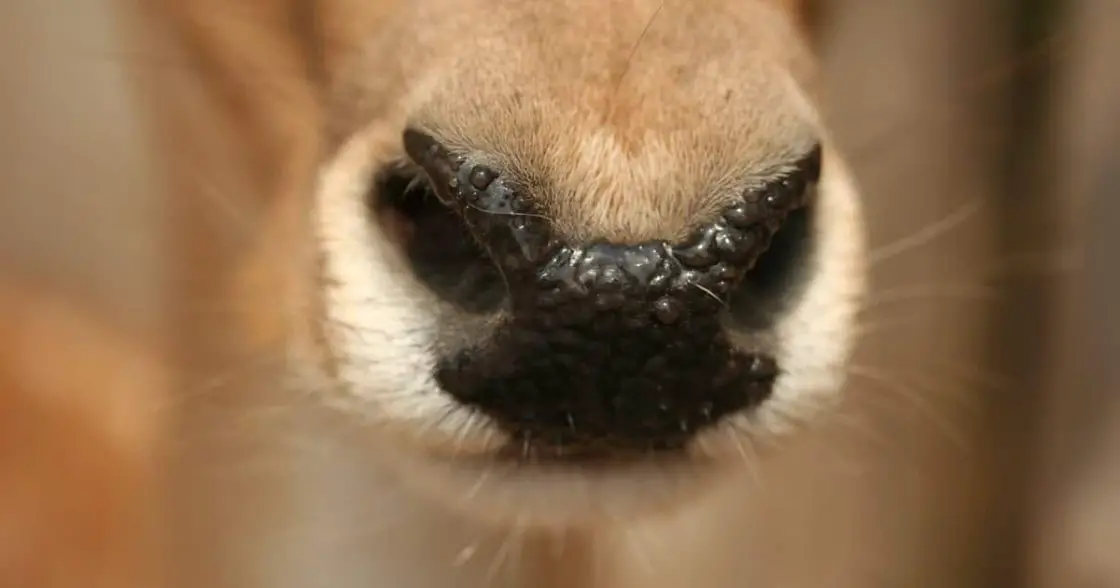Deer have one of the most powerful noses in the animal kingdom. In fact, their unique nose give deer a sense of smell that is anywhere from 500 to 1,000 times more powerful than ours. The deer nose is essential for these animals to detect predators at a distance and sniff out food that’s safe to eat. Let’s learn more about this animal’s nose and discover the characteristics that make it so extraordinary.
Each aspect of a deer nose helps in some way, from the length of the snout to how it stays consistently moist. The deer nose means that this animal can smell any minor changes in its environment.
Let’s learn more about the deer nose and this animal’s incredible sense of smell. We’ll also take a look at how the deer’s sense of smell compares to that of some other animals, as well as some smells that deer enjoy.
How Does a Deer’s Sense of Smell Work?
The deer’s nose (including its snout) comes together with its brain to provide its sense of smell.
Smells and scents are caused by molecules in the air that something or someone produces.
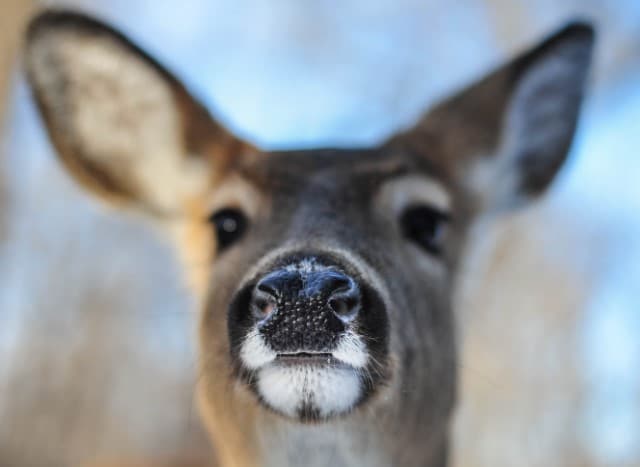
These molecules are called volatile organic compounds (VOCs). They are organic compounds that get evaporated into the air whenever something smells them, due to their high vapor pressure.
For example, when we sniff a flower, we’re able to smell the perfume because our action of sniffing evaporates the VOCs from the surface of the petals.
But we have to be extremely close to a flower in order to smell it. Deer, by contrast, can detect these odors from a distance.
The Deer Snout
The deer’s long snout is pivotal to its acute sense of smell. It’s significantly longer than the snouts we see on other animals with a strong sense of smell and a sensitive nose surrounded by whiskers.
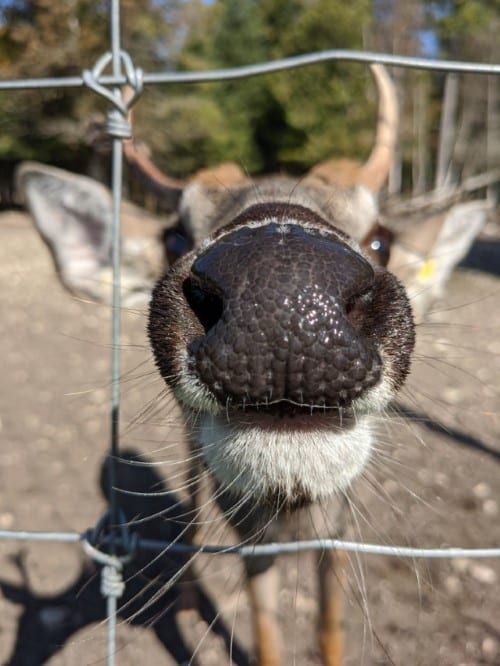
This length means that it can fit all the extra olfactory receptors that the deer nose needs to find and interpret different smells.
The deer sucks VOCs into its large nostrils whenever it inhales a scent. The hair-like nerves called cilia then dissolve the VOCs.
The resulting molecules pass into the olfactory epithelium, which holds all of the olfactory nerves.
300 Million Olfactory Receptors
There are about 300 million olfactory receptors found in the deer snout. Some of the olfactory nerves in deer are specialized, meant to pick up on specific scents.
For example, some deer species have specialized receptors to pick up on predator scents, primarily wolves.
Large Olfactory Bulb
In addition to a deer’s olfactory receptors, a certain part of their brain is specialized to help them smell. This is called the olfactory bulb. A deer’s olfactory bulb is much larger than ours.
When a deer smells something, the scent passes through the olfactory receptors and into the brain as electrical impulses. The impulses then travel to the part of the brain that deals with smell, known as the olfactory bulb.
How Good Is a Deer’s Nose?
A deer’s nose is so sensitive that it can differentiate between hundreds of different smells, all while sniffing them all simultaneously.
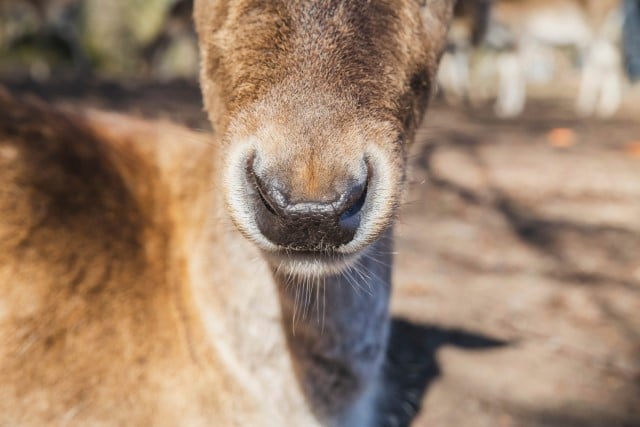
There are many different things going on at a given moment in the wild. Smells often accompany those things.
Let’s take a look at all the amazing things a deer’s nose can do.
It Detects Predators
When a predator is moving through the woods, even if it’s very silent, a deer’s nose will be able to pick up on their movement and the direction the predator is coming from.
They will also be able to tell what the predator is, whether it’s a wolf, bear, or another common predator. This will let the deer know how serious the threat is, and the best method to escape.
It Helps the Deer Find Safe Food Sources
Of course, deer also use their noses to find food.
Deer usually eat things you would find on a forest floor, such as plants, berries, and mushrooms. However, not all of these are safe to eat.
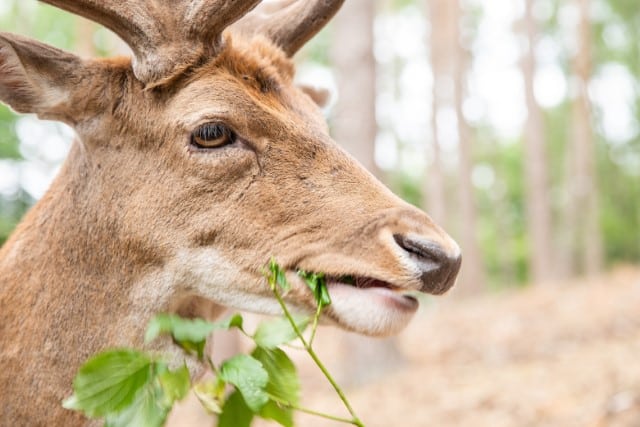
There are quite a few species of berries, plants, and mushrooms that would be fatal to the deer if eaten.
Fortunately, the deer’s sense of smell lets them differentiate between safe and unsafe food sources. That’s because of how their noses detect the differences between poisonous chemicals and safe ones.
It Keeps the Herd Together
A deer will also use its nose to locate other deer in its herd. Every deer herd has its own unique scent, and while this might not be apparent to humans, it is to deer.
So when a deer gets separated from its herd, it can use its sense of smell to find its way back.
In 2018, researchers at Mississippi State University discovered that the sense of smell plays a major part in deer communication.
How Far Away Can the Deer Nose Smell?
Deer can smell approaching dangers from at least half a mile away, maybe more. This ability is due to how sensitive a deer’s nose is not just on the inside, but on the outside as well.
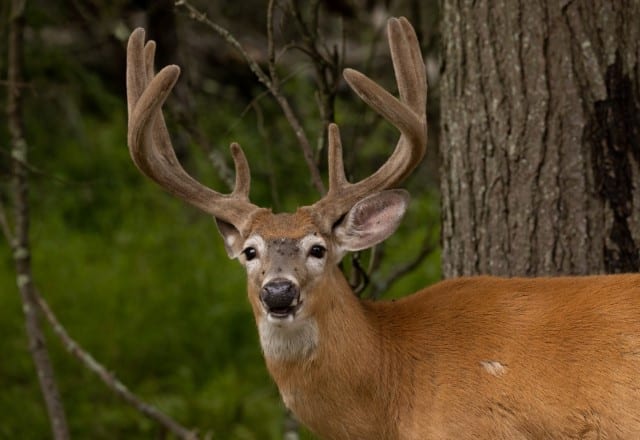
There are two main characteristics of the deer nose that makes it able to detect scents from so far away. These are its wetness and its texture.
Nose Wetness
Deer regularly lick their noses, keeping them moist. And they’re constantly scanning the air for any indicators of a new odor.
That’s why you sometimes spot them with their snouts in the air.
Volatile organic compounds (VOCs) are floating through the air, coming from anything that gives off a scent. This includes animals and plants.
When the VOCs get close enough to a deer’s nose, they stick to it. That is because the nose is moist.
The deer’s wet nose can also help it sort through the odors it is smelling. It does this by slowing down the smells as they make their way through the nostrils and to the olfactory receptors.
Nose Texture
The bumpy texture of a deer’s nose also plays a role in how far a deer can smell. This kind of texture increases the nose’s surface area, making it more capable of picking up on the VOCs in the air.
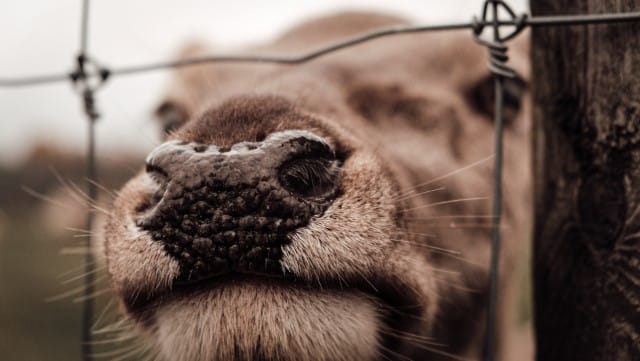
The bumpy texture also helps the nose to trap the molecules better, so the deer can smell each of them.
A smooth nose wouldn’t be effective at picking up the VOCs because they would just slide off, making it difficult for the deer to smell them.
Deer vs Human Sense of Smell
Compared to a human sense of smell, a deer’s sense of smell is about 500 to 1,000 times more powerful.
This makes it very difficult to hunt deer since they are able to detect a human’s scent from a significant distance away, giving the deer adequate time to escape.
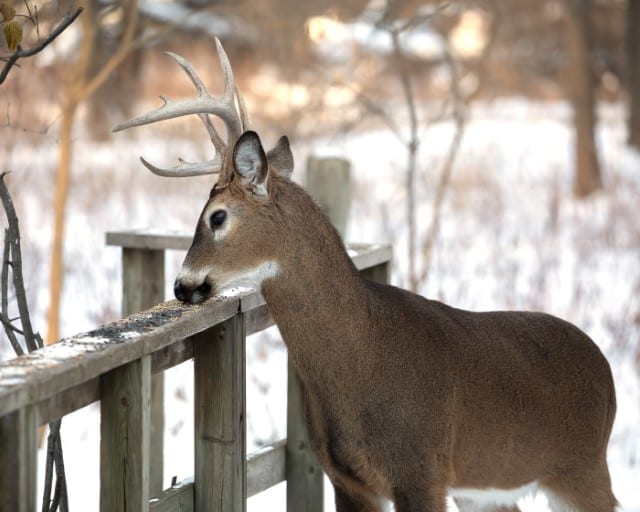
Some hunters use products called scent sprays to help overcome this.
Scent sprays are meant to disguise the scent that a human gives off, or at the very least suppress it. There is some debate as to how well scent sprays actually work.
Some hunters say that these sprays do work if you apply them liberally and consistently throughout the hunting trip.
Other hunters argue that deer are able to smell the scent of the spray and learn when humans are nearby, so the sprays aren’t effective.
Deer vs Dog Sense of Smell
It’s a bit trickier to compare a deer’s sense of smell to a dog’s sense of smell.
Different dog breeds have varying senses of smell. For example, scenthound hunting dogs have been specifically bred for a heightened sense of smell to track their prey.
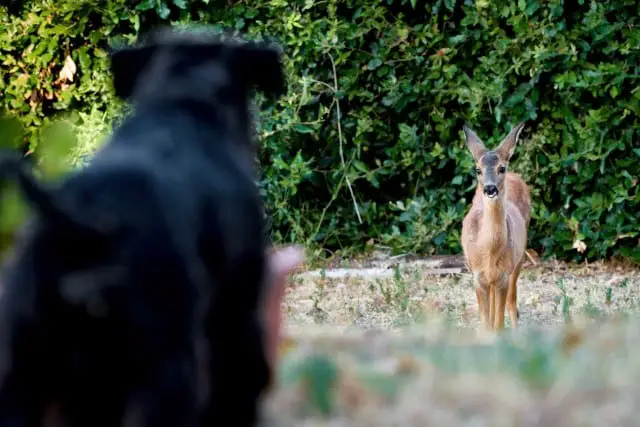
But on average, a deer’s sense of smell is about ⅓ times more powerful than a dog’s sense of smell.
Most dogs have the same bumpy texture and wet nose as deer, but their sense of smell is more powerful than a deer’s because of how many olfactory receptors are in their noses.
Most dog breeds have only about 1 billion olfactory receptors in their noses. However, dogs that were bred for hunting, such as bloodhounds, have about 4 billion olfactory receptors.
What Smells Do Deer Like?
Some hunters use smells that deer like to attract these animals. A few scents that will attract deer include:
- Peanut butter
- Molasses or syrup
- Fruit
Peanut butter is a popular scent that hunters like to hang from a tree or place on a stump to attract deer. Simply opening a jar of peanut butter and setting it up in the forest is enough to attract the deer to it.
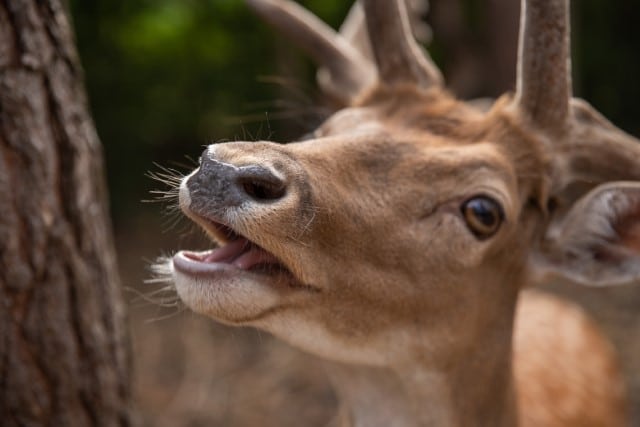
If you want it to be extra effective, try smearing peanut butter on a stick or some leaves.
Deer also really enjoy sweet scents, such as molasses or syrup and fruit. You can use the same method described above with the peanut butter.
But you have to make sure the deer are able to reach the molasses or syrup so they can lick it up. This will give you the opportunity to sneak up on them.
Rotten fruit is the best kind of fruit to leave out, particularly apples.
You can even dip apples in syrup or molasses and hang them from a tree to bring deer your way.
Final Thoughts About the Deer Nose
As we’ve learned here, deer have one of the most powerful noses in the animal kingdom. Each detail and element, from the texture of their nose to the structure of their brain, helps them use smell as a tool to survive.
Without their sense of smell, a deer would be unable to detect and avoid predators or ensure that the food they eat is safe. Understanding the deer nose and this animal’s sense of smell is key to hunting success.

